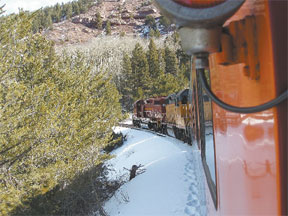Published: Friday February 10, 2006
 |
CHIEFTAIN PHOTO/ERIN SMITH
The San Luis and Rio Grande tourist train leans
around a curve Thursday on its inaugural three-hour run from Alamosa to La Veta.
|
Train
ride over La Veta Pass imparts nostalgic feelings
By ERIN SMITH
THE PUEBLO
CHIEFTAIN
ALAMOSA - The thrill of riding a well-appointed passenger train over
La Veta Pass was evident on the faces of happy passengers Thursday.
The debut of the new seasonal passenger train from Alamosa to La Veta was special for
Debra Goodman, manager of the Alamosa County Chamber of Commerce, who climbed aboard a
Pullman sleeper car built in 1948.
Also on board was Stephen Rasmussen, who wrote “The Rio Grande’s La Veta
Pass Route: Gateway to the San Luis Valley.”
Passionate about trains since he could crawl, Rasmussen wrote the tome “because
he is a rebel and no one else knew about the line,” his wife Pam explained.
There was hoopla at the historic Alamosa station. Following a brief ceremony, the
train pulled out of the station, which will be the location of departures during the
season that will run from mid-May to mid-October, to coincide with the Cumbres &
Toltec Scenic Railroad's runs out of Antonito. There also will be a run from Alamosa to
Antonito to link passengers with the narrow gauge.
From Alamosa east to La Veta, the train tracks parallel U.S. 160 through Blanca and
Fort Garland, giving passengers a slightly different view of the Sand Dunes, Mount Blanca
and the mountains. East of Fort Garland, the train meanders through the Sangre de
Cristos, still south of the highway.
The ride is incredibly smooth. Unlike the
C&TSRR, a narrow gauge train, the San Luis Express is a standard gauge. There is
almost no click-clack sound like on the narrow gauge. However, when one walks, there is
an impression of being somewhat tipsy.
The train travels through two tunnels and goes around a horseshoe turn on the 60-mile
run. Every foot of track presents a new view.
Ed Ellis, president of the San Luis and Rio Grande Railroad, explained that his
company, Iowa Pacific Holdings, bought the train from Rail America. Originally the Rio
Grande Western Railroad, the train later belonged to Southern Pacific and then the Union
Pacific before Rail America. The line handles more than 6,000 freight car loads each
year.
Ellis said the freight trains hauling potatoes, barley and perlite out of the San Luis
Valley are what make his company money. The trains will continue to run, but won’t
interfere with the passenger trains.
Ellis said he and Don Shank, head of the Denver-Rio Grande Historical Foundation, put
the passenger run together shortly after Iowa Pacific bought the line in December.
“I had to buy the railroad in order to ride the train,” Ed said.
Mile after mile of wonderful scenery on the sun-bright day passed before the train
pulled into La Veta about 1 p.m. There the train was greeted by an estimated 400 people
and scores of schoolchildren. Most of the crowd was wearing red for what was indeed a
red-letter day.
Although there have been special trains over the route throughout the years, the last
regular passenger train chugged down the tracks June 1, 1953, Steve Rasmussen said.